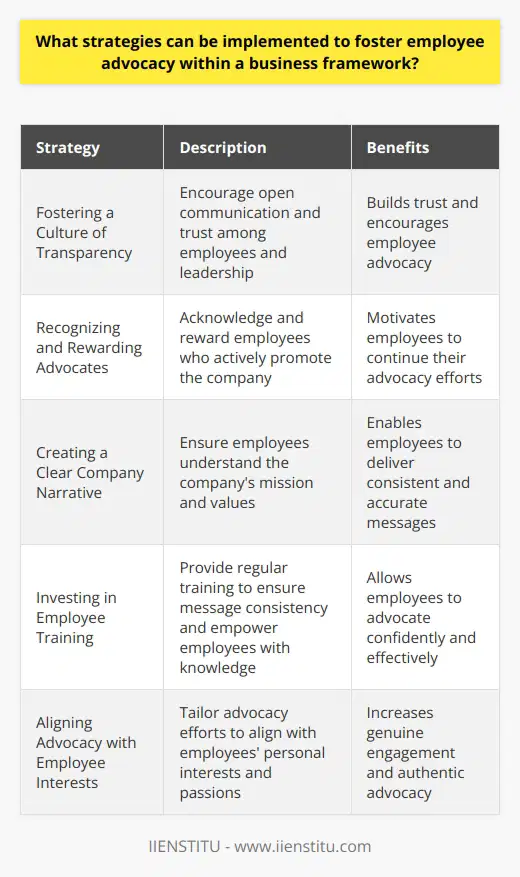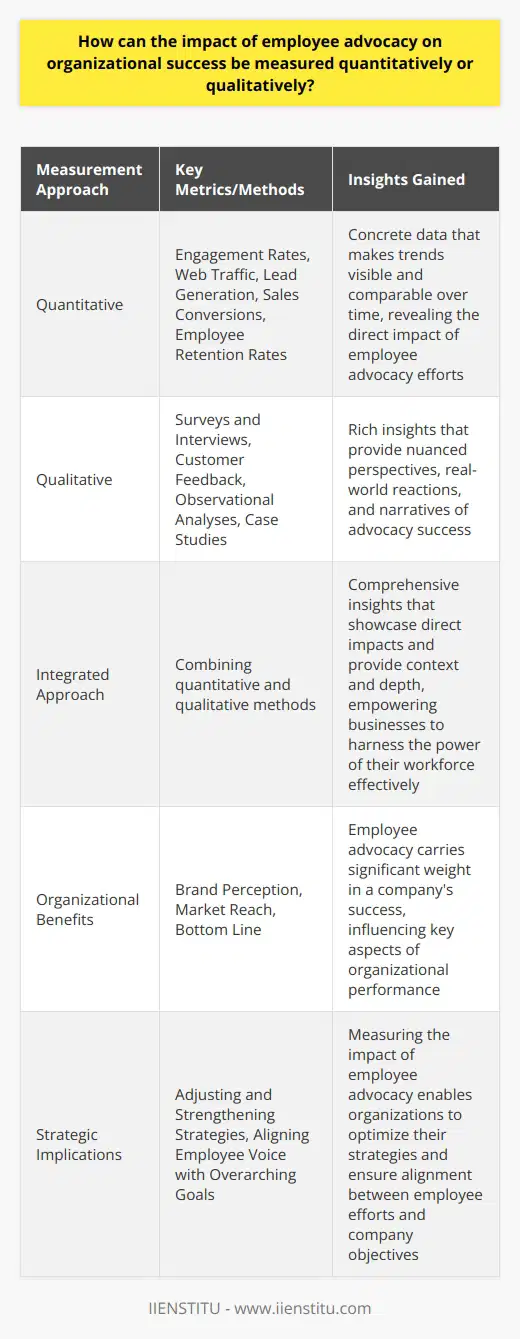
In the challenging landscape of today's business world, the success of an organization is increasingly dependent on the collective efforts of its workforce beyond the conventional scope of duties. Drawing attention to this very crux stands the concept of employee advocacy: the promotion of an organization by its own staff members.
As a cornerstone in building brand equity and forging authentic connections with customers, employee advocacy represents a fusion of personal employee narratives with the organizational mission. This academic article delves into this ecosystem, exploring the mechanics and merits of implementing an effective employee advocacy program, as well as its centrality to contemporary organizational triumph.
Understanding the Concept of Employee Advocacy
Explanation of Employee Advocacy
Employee advocacy is the endorsement of a company or organization by its own employees, who share their support for the company's brand, products, or services through their personal social networks.
This organic form of marketing comes from the premise that employees, as trusted insiders and relatable figures, can significantly influence public perception about their employer. With social media serving as a ubiquitous communication platform, the power of employee advocacy becomes more potent than ever, creating an opportune moment for businesses to harness the enthusiasm and connectivity of their employees.
The Influence of Employee Advocacy on Business Reputation
An employee's advocacy contributes positively to business reputation by adding credibility and a human touch to the corporate narrative. When employees speak favorably about their work environment or the products and services they are involved with, it resonates with their personal networks.
This peer-to-peer sharing is implicitly respected and trusted, effectively becoming a powerful form of word-of-mouth advertising. Consequently, an organization with a strong employee advocacy base enjoys enhanced reputability and often finds itself standing out among competitors.
The Role of Employee Advocacy in Brand Awareness
Brand awareness is dramatically amplified through employee advocacy. As individuals post about their company on social media or share in face-to-face interactions, they cast a wider net for the brand's visibility.
It is a multiplicative effect where each employee's reach extends the brand's presence across numerous untapped audiences. This level of exposure is particularly impactful because it is delivered through the voices of people familiar to those audiences, making it more relatable and compelling than traditional marketing efforts.
The Benefits and Advantages of Employee Advocacy
Enhanced Overall Brand Recognition
Through consistent and positive employee engagement online, there is a marked improvement in overall brand recognition. Not only does employee advocacy expand the reach of corporate messages, but it also personalizes and humanizes the brand in the public eye. Employees become ambassadors, and their narratives about the company’s culture and mission contribute to a more nuanced and relatable brand image.
Building Trust with Customers and Stakeholders
Trust is a currency of immeasurable value, and employee advocacy aids in accumulating this wealth. As employees share their real-life experiences, stories of dedication, and customer success stories, trust builds between the company and its stakeholders. Whether current or potential customers, investors, or partners, they all tend to lean more favorably towards a company that is openly appreciated by its employees.
Increased Employee Engagement and Job Satisfaction
By cultivating a culture of advocacy, companies inadvertently boost employee engagement and job satisfaction. Employees who feel empowered to speak on behalf of their place of work are more likely to feel valued and connected to the broader corporate objectives. This sense of ownership and pride feeds back into overall job satisfaction, leading to reduced turnover rates and stronger internal morale.
Improved Revenue Generation and Business Performance
There exists a tangible link between these aforementioned factors and the bottom line of a business. Organizations with strong employee advocacy programs often notice an uptick in leads and sales, primarily due to the authentic customer connections established by staff members’ social networks. Moreover, business performance is bolstered by the alignment and collaboration of a workforce that is actively participating in the company's market presence.
Real-life Examples of Successful Employee Advocacy
Examples abound when it comes to successful employee advocacy. Tech giants, retail brands, and even small startups have all reaped the benefits of such programs. Companies like Adobe, Dell, and Starbucks have active and structured advocacy campaigns where employees regularly share positive workplace experiences and product launches, resulting in significant brand momentum.
How to Develop and Implement an Effective Employee Advocacy Program
Importance of Leadership Engagement
Leadership plays a pivotal role in setting the tone for employee advocacy. Executive buy-in and participation are crucial as they lead by example, demonstrating the organization's commitment to the cause. Senior managers and executives should not only endorse the advocacy program but also participate in sharing and communicating their own belief in the company's mission and values.
Nurturing a Positive Company Culture
A positive company culture is the bedrock of a robust employee advocacy program. Organizations must create an environment that is conducive to open communication and sharing. This includes recognizing and rewarding employee contributions, celebrating individual and team successes publicly, and establishing trust through transparency and integrity in business practices.
Provision of Proper Employee Training and Education
Implementing an employee advocacy program also requires providing proper training and resources for employees. They should feel equipped to share company news and updates in a way that aligns with brand messaging while maintaining authenticity. This might involve online certification courses or specialized hr certificate course offerings that teach effective communication skills, social media best practices, and insights into the company's content strategy.
Using the Right Tools for Employee Advocacy
To streamline and optimize advocacy efforts, companies should leverage the appropriate tools and platforms. Social media is a key conduit for sharing content, but internal networking platforms, company blogs, and even dedicated advocacy software can play a part. These tools should be user-friendly and integrated into the day-to-day workflow of employees to ensure maximum participation and ease of use.
Challenges and Potential Pitfalls in Employee Advocacy
Risk of Negative Publicity and Damage to Brand Image
While employee advocacy has numerous benefits, it is not without its potential risks. One significant challenge is the possibility of negative publicity stemming from well-intentioned but poorly executed employee shares. Misinformation, leaked confidential information, or posts in poor taste can easily damage a company’s brand image.
Employee Discomfort or Resistance
There might also be instances where employees are uncomfortable with participating in advocacy due to privacy concerns or simply because they do not want to blend their professional and personal lives. Companies must be sensitive to these preferences and should never mandate employee participation in advocacy programs.
Appropriate and Ethical Use of Social Media
Another potential pitfall is ensuring the appropriate and ethical use of social media by employees. Organizations have a responsibility to educate their workforce on what constitutes ethical social media practices both in relation to the brand and society at large. This includes staying clear of controversial topics or engaging in online debates that could reflect poorly on the company.
Addressing and Overcoming these Challenges
Overcoming these challenges involves a combination of diligent planning, robust training, clear communication of expectations, and a culture that encourages cautious, yet genuine sharing. It is also important for companies to have a crisis management strategy in place should any significant issues arise, ensuring that appropriate measures can be quickly taken to mitigate any negative impact.
Measuring the Impact of Employee Advocacy
Identifying Key Performance Indicators (KPIs)
To effectively measure the impact of an employee advocacy program, it is essential to identify appropriate KPIs. These could include metrics such as engagement rates, reach, conversion rates, and lead generation statistics. Having a clear set of measurable outcomes will help organizations to assess the success of their advocacy efforts and make necessary adjustments.
Understanding Social Analytics and Their Role in Measurement
Social analytics play a fundamental role in measuring advocacy. These analytics provide insights into how content is performing, which platforms are yielding the most engagement, and how employee posts are contributing to overarching marketing goals. By understanding these metrics, businesses can gain a better understanding of the return on investment of their advocacy programs.
Examples of Success Metrics in Employee Advocacy
Some companies have reported significant rises in brand-related searches, higher web traffic referrals from social media, and an increase in earned media value as direct results of employee advocacy. Moreover, internal metrics such as employee participation rates and sentiment analysis can serve as indicators of the effectiveness and impact of these programs on the workforce itself.
Recap of the importance and benefits of Employee Advocacy
In conclusion, employee advocacy stands as a critical component of modern organizational success. By leveraging the collective voices of their workforce, companies enjoy heightened brand awareness, trust, engagement, and, significantly, financial performance. The reciprocal benefits of advocacy programs serve to bolster not only the company's market position but also its internal cohesion.
Final Thoughts on Effective Employee Advocacy Strategies
Effective employee advocacy strategies hinge on committed leadership, a supportive company culture, comprehensive employee education, and the thoughtful application of social tools. When executed with consideration to potential risks and consistently measured against clear performance indicators, advocacy programs can thrive and deliver tangible benefits.
Encouragement for Businesses to Utilize Employee Advocacy for Growth and Success
Businesses are encouraged to harness the power of their most valuable assets – their employees. By promoting a healthy environment where advocacy is valued and nurtured, organizations can utilize this approach for sustained growth and success. In essence, authentic employee voices can become one of the most impactful channels through which a company can cement its reputation and achieve its strategic objectives.
Frequently Asked Questions
How does employee advocacy contribute to overall organizational success?
Employee Advocacy and Organizational Success
Employee advocacy emerges as a crucial element in the growth and success of organizations. This concept relies on employees to act as ambassadors. They communicate positive aspects of their workplace to the outside world. Organizations thereby benefit from these credible endorsements.
What Makes Employee Advocacy Powerful?
Employees hold authentic insights. They understand internal operations uniquely. This firsthand experience allows them to share compelling stories. Stories attract potential customers and future employees.
Credibility forms the foundation of employee advocacy. People trust individuals over corporations. This trust translates into a broader and more sincere company representation.
The Multiplier Effect
Employee advocacy amplifies marketing efforts. Consider each employee as a node in an expansive network. Their social reach extends the brand's voice into diverse communities. Organic shares and posts multiply the spread of content. Each employee's network represents a potential customer base.
A Boost in Recruitment
Advocacy also enhances recruitment. Prospective employees gauge company culture through existing staff. Positive employee testimonials attract top talent. They portray the organization as an employer of choice.
Internal morale receives a boost. Acknowledged, involved staff express higher job satisfaction. They tend to maintain greater loyalty. This loyalty translates into lower turnover rates.
The Cycle of Success
Advocacy strengthens brand awareness and reputation. Positive employee narratives foster trust. Trust in turn generates customer loyalty. This cycle creates a favorable business environment. An environment where success becomes more attainable.
Key Takeaways
Employee advocacy leverages the power of personal endorsement.
Trust drives the effectiveness of advocacy.
The spread of content grows exponentially through employee networks.
Recruitment gains from positive internal promotion.
Advocacy boosts morale, loyalty, and job satisfaction.
The cycle of trust and loyalty feeds into organizational success.
In conclusion, employee advocacy serves as a linchpin for organizational triumph. It enhances marketing, recruitment, and company image. This unique blend of personnel participation and strategic brand reinforcement drives organizations toward undeniable success.

What strategies can be implemented to foster employee advocacy within a business framework?
Employee Advocacy and Business Frameworks
Understanding Employee Advocacy
Employee advocacy leverages staff to promote a company. It exploits their networks for brand messaging. Advocates amplify company values externally. This fosters trust and expands reach.
Fostering a Culture of Advocacy
First, leaders must espouse transparency. Open communication breeds trust. Employees embrace companies they trust. Trust fosters advocacy.
Recognizing and Rewarding Advocates
Acknowledgment fuels motivation. Frequent recognition encourages continued support. Rewards speak louder than words. They substantiate verbal recognition.
Creating an Unmistakable Company Narrative
Employees must understand the company's mission. Clarity assures accurate representation. Representatives deliver clear, consistent messages.
Investing in Training
Regular training ensures message consistency. It empowers employees with knowledge. They can then advocate confidently.
Establishing a Social Media Policy
Clear guidelines protect both company and employee. Knowledge of boundaries instills confidence. Confident employees participate more actively.
Encouraging Leadership to Participate
Employees mimic their leaders. Leaders should model advocacy. This behavior trickles down, influencing the workforce.
Providing the Necessary Tools
Platforms simplify advocacy. Tools track efforts and rewards. Easy access to content is essential.
Collecting and Acting on Feedback
Feedback pinpoints areas for improvement. Employees feel heard. Valued employees become committed advocates.
Aligning Advocacy with Employee Interests
Personal relevance spurs genuine advocacy. Aligning interests increases authentic engagement.
Showcasing Success Stories
Success stories inspire others. They illustrate the impact of advocacy. Employees see the direct benefits.
Monitoring and Measuring Impact
Tracking effectiveness guides strategy adjustments. Effective monitoring informs future advocacy efforts.
Businesses thrive with strong employee advocates. Implementing these strategies fosters a supportive environment. Said environment nurtures advocacy within a business framework.

How can the impact of employee advocacy on organizational success be measured quantitatively or qualitatively?
Understanding Employee Advocacy
Employee advocacy reflects how actively employees support and promote their organization. At its core, it captures a workforce's willingness to champion the company they work for. Both internally and externally, this phenomenon can propel organizational success forward. Thus, to gauge this impact requires a blend of quantitative and qualitative methods. Each approach yields insights into the effectiveness of employee advocacy efforts.
Quantitative Measurements
Quantitative analysis offers concrete data. It makes trends visible and comparable over time. Below are key metrics organizations can use:
Engagement Rates
One can track social media metrics when employees share company content. Likes, shares, and comments reflect engagement levels. These numbers provide a direct line of sight to advocacy reach.
Web Traffic
Referral traffic stemming from employee-shared links is measurable. An uptick signals more interest due to staff endorsements.
Lead Generation
Employee networks can generate leads. Tracking these leads reveals advocacy strength in driving business.
Sales Conversions
When employees share product or service information, they can influence sales. Companies can track these conversions tied to staff referrals.
Employee Retention Rates
Over time, high retention rates can signal strong employee engagement. Advocates usually stay with companies they believe in.
Qualitative Assessments
Qualitative methods, though less numerical, yield rich insights. These include:
Surveys and Interviews
Gathering feedback from employees on advocacy programs offers nuanced perspectives. It reveals how staff feel about representing their employer.
Customer Feedback
Customers can provide testimonials on how employee advocacy affected their perception. They offer real-world reactions to the organization's brand as shaped by staff.
Observational Analyses
Monitoring the tone and content of employee-shared messages reveals advocacy quality. It shows how well staff understand and communicate the company's message.
Case Studies
Highlight examples where employee advocacy had a visible impact. Cases illustrate the narrative of advocacy success.
Integrating Both Approaches
Organizations benefit most when combining quantitative and qualitative methods. This integrated approach yields comprehensive insights. Numbers showcase direct impacts, while stories give context and depth. Thus, leadership gains a fuller picture of advocacy's role in organizational success.
Employee advocacy carries significant weight in a company's success. It influences brand perception, market reach, and ultimately, the bottom line. By measuring its impact through a mix of quantitative and qualitative lenses, organizations can adjust and strengthen their strategies. This ensures that the voice their employees project aligns well with their overarching goals. The right blend of data and narrative empowers businesses to harness the power of their workforce effectively.



